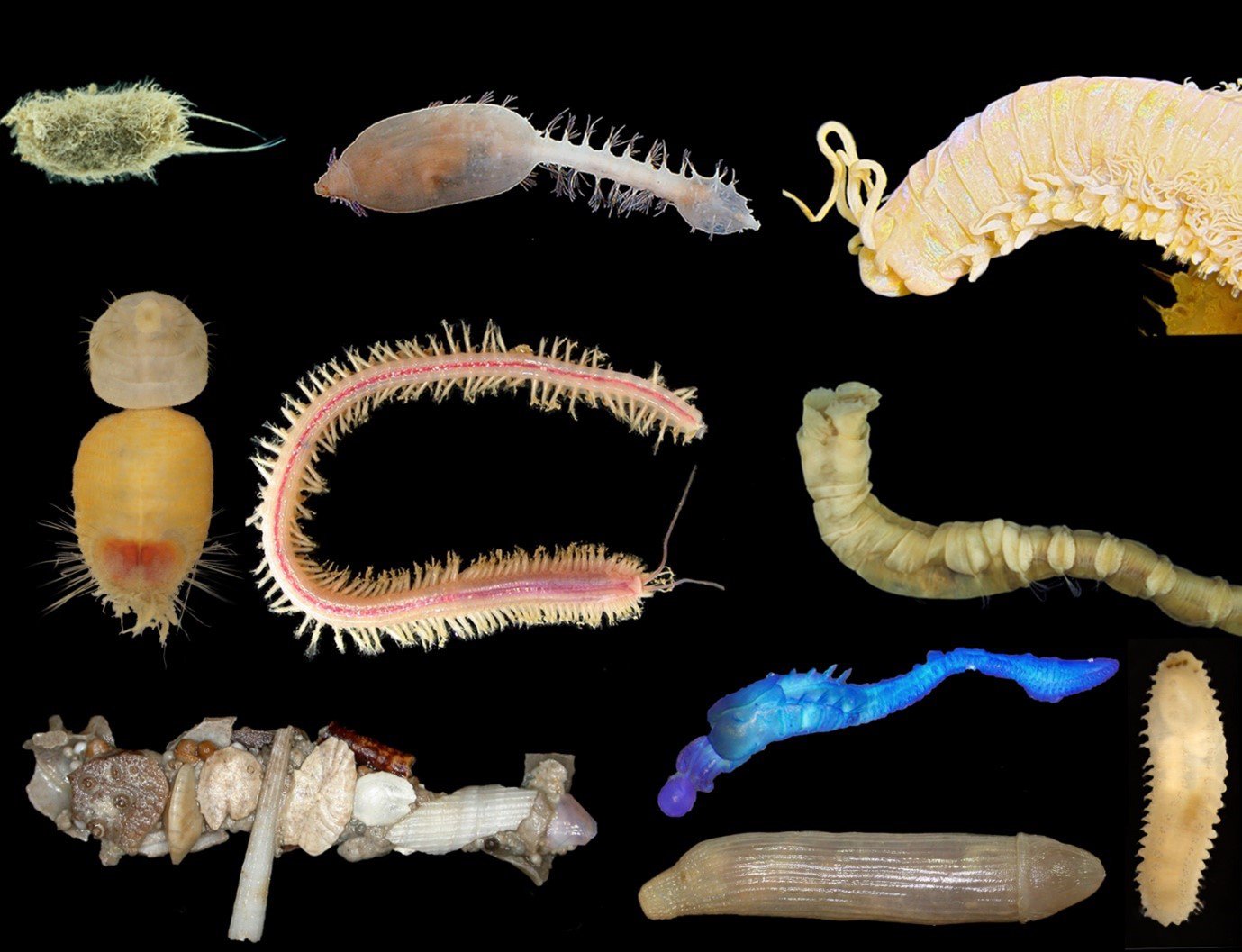Australian abyssal worms: research reveals the unnamed species living in our deep-sea environments
A recently published international study including 30 authors from 19 institutions, led by the Australian Museum, has indicated that over 50 new species of marine worm from the eastern Australian abyss await to be described and named.
Have you ever wondered what lives in the deep sea? Are you curious about what kind of organisms can survive below 1,000 metres and even deeper? The surprising answer is that the oceans are teeming with life from the narrow fringe between the tides (intertidal zone) down to the deepest ocean trenches (around 11,000 metres). Organisms found thriving in the remote deep-sea environment include fish, crabs, sponges, starfish, corals, molluscs and worms.

Described species from the Australian abyss. A) Petta investigatoris B) Petta williamsonae C) Melinnopsis chadwicki D) Melinnopsis gardelli E) Gesaia csiro F) Phalacrostemma timoharai.
Image: Jinghuai Zhang and Laetitia Gunton© Jinghuai Zhang and Laetitia Gunton
How do we know this and is the deep-sea environment well-researched in Australia? You may think the east coast of Australia is the best studied in the continent – the Great Barrier Reef is world famous and an iconic symbol of Australia, and there is relatively high population density and research capacity along the east coast. Yet, until recently, the deep seas (deeper than 200 metres) off the east coast were extremely poorly sampled for biology. From the British Challenger expedition in 1874 to the Tangaroa voyage from New Zealand in 1982, only seven biological samples had been collected from abyssal depths (3,000 – 6,000 metres) along the length of eastern Australia. Furthermore, these were all collected by non-Australian cruises whilst passing through the area.
This dearth of sampling motivated the pioneering 2017 Research Vessel Investigator expedition, ‘Sampling the Abyss’ to the eastern Australian abyss. The cruise was the first to systematically collect biological samples from Tasmania to southern Queensland, from 1,000 to 4,000 metres in depth. From this month-long cruise, a staggering 25,710 organisms were collected and the majority (58% of the species) were thought to be new to science. An immense range of organisms were found at these depths including sponges, corals, octopuses, fish, crabs, lobsters, starfish, sea cucumbers, sea anemones, and importantly for the present study – over 6,000 worm specimens! These worm specimens were sent to the AM to be studied and incorporated into the Marine Invertebrate collections.
Here at the AM, we were able to identify many specimens to species level. However, worms are extremely morphologically diverse, meaning they don’t all look like the common garden earthworm. The phylum Annelida, which we work on at the AM, contains over 80 families. Generally, a worm taxonomist will specialise on a few or just one family; therefore we needed help from our colleagues and sent specimens to Museums Victoria, Melbourne and further afield to specialists in China, Germany, Italy, Japan, Norway, Poland, Russia, Spain and the UK. In total around 1,800 worms were sent to international specialists.

Annelid worms discovered from the Australian eastern abyss but awaiting description. Images from Gunton et al. 2021.
Image: Gunton et al. 2021.© Naoto Jimi, Ingo Burghardt, Robin S. Wilson, Karen Gowlett-Holmes, Jon A. Kongsrud, Elena K. Kupriyanova, Maria Capa.
Before this study, only 15 worm species were formally described (given scientific names) from Australian waters below 1,000 metres. Our study reports at least 214 species of worm, 55 of which are new to science and await to be described. So far we have described six species: Petta investigatoris, Petta williamsonae, Gesaia csiro, Phalacrostemma timoharai Melinnopsis gardelli and Melinnopsis chadwicki (Image 1). Our team of international worm collaborators is now working away on new species descriptions (Image 2) which will be published soon in the Records of the Australian Museum.
And this is just the tip of the iceberg! There are likely to be thousands of undescribed worm species burrowing around in Australian deep-sea sediments. Our study is the first baseline record of deep-sea worm species from Australia and one of only a handful of invertebrate datasets from this area. It is always exciting to discover who is in our own backyard (back ocean!).
Dr Laetitia Gunton, Technical Officer Digitisation, Marine Invertebrates, Australian Museum Research Institute; 2018-20 recipient of the Chadwick Biodiversity Fellowship.
More information:
- Gunton, L. M., Kupriyanova, E. K., Alvestad, T., Avery, L., Blake, J. A., Biriukova, O., Böggemann, M., Borisova, P., Budaeva, N., Burghardt, I., Capa, M., Georgieva, M. N., Glasby, C. J., Hsueh, P.-W., Hutchings, P., Jimi, N., Kongsrud, J. A., Langeneck, J., Meißner, K., Murray, A., Nikolic, M., Paxton, H., Ramos, D., Schulze, A., Sobczyk, R., Watson, C., Wiklund, H., Wilson, R. S., Zhadan, A. & Zhang, J. 2021. Annelids Of The Eastern Australian Abyss Collected By The 2017 RV ‘Investigator’ Voyage. Zookeys, 1020. doi: 10.3897/zookeys.1020.57921
- Marrison, M. 2020. Bristling with pride: abyssal bristle worm named in our honour. CSIROscope.










